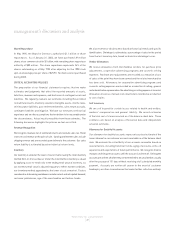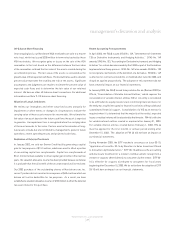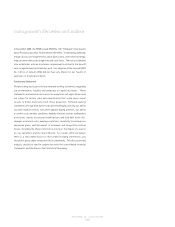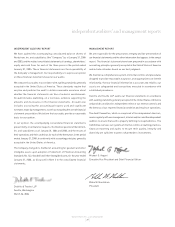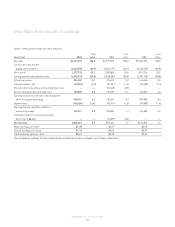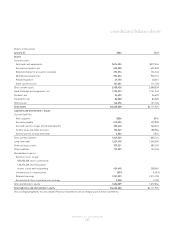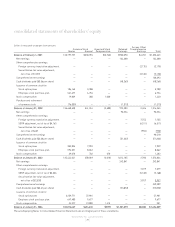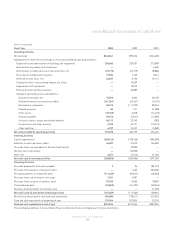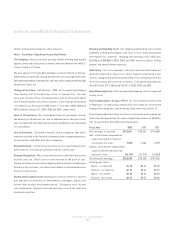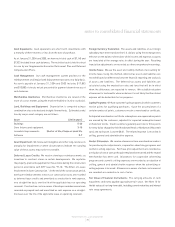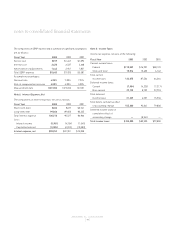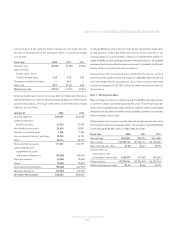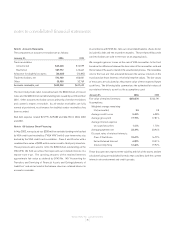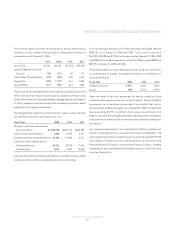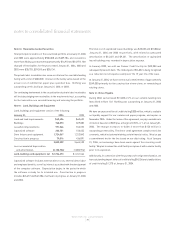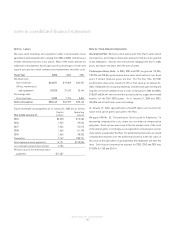Nordstrom 2003 Annual Report Download - page 34
Download and view the complete annual report
Please find page 34 of the 2003 Nordstrom annual report below. You can navigate through the pages in the report by either clicking on the pages listed below, or by using the keyword search tool below to find specific information within the annual report.NORDSTROM, INC. and SUBSIDIARIES
[32 ]
Derivatives Policy: We limit our use of derivative financial instruments
to the management of foreign currency and interest rate risks. Our
derivative financial instruments for foreign currency are not material to
our financial condition or results of operations and we have no material
off-balance sheet credit risk. See Note 13 for a further description of our
interest rate swaps.
Recent Accounting Pronouncements: In April 2003, the FASB issued
SFAS No. 149, “Amendment of Statement 133 on Derivative Instruments
and Hedging Activities.” SFAS No. 149 amends SFAS No. 133, “Accounting
for Derivative Instruments and Hedging Activities” for certain decisions
made by the FASB as part of the Derivatives Implementation Group
process. SFAS No. 149 also amends SFAS No. 133 to incorporate
clarifications of the definition of a derivative. SFAS No. 149 is effective for
contracts entered into or modified after June 30, 2003, and should be applied
prospectively. The adoption of this statement did not have a material
impact on our financial statements.
In January 2003, the FASB issued Interpretation No. 46 (Revised 2003) or
FIN 46, “Consolidation of Variable Interest Entities,” which requires the
consolidation of variable interest entities (VIEs). An entity is considered
to be a VIE when its equity investors lack controlling financial interest or
the entity has insufficient capital to finance its activities without additional
subordinated financial support. Consolidation of a VIE by an investor is
required when it is determined that the majority of the entity’s expected
losses or residual returns will be absorbed by that investor. FIN 46 is effective
for variable interest entities created or acquired after January 31, 2003.
For variable interest entities created before February 1, 2003, FIN 46
must be applied for the first interim or annual period ending after
December 15, 2003. The adoption of FIN 46 did not have an impact on our
financial statements.
During November 2003, the EITF reached a consensus on Issue 03-10,
"Application of Issue No. 02-16 by Resellers to Sales Incentives Offered
to Consumers by Manufacturers." EITF 03-10 addresses the accounting
and disclosure treatment for a retailer’s reimbursement receipt from a
vendor for coupons offered directly to consumers by the vendor. EITF 03-
10 is effective for coupons distributed to consumers for fiscal years
beginning after December 15, 2003. We do not believe the adoption of EITF
03-10 will have an impact on our financial statements.
In December 2003, the FASB revised SFAS No. 132, "Employers' Disclosures
about Pensions and other Postretirement Benefits," establishing additional
annual disclosure requirements about plan assets, investment strategy,
measurement date, plan obligations and cash flows. The revised standard
also establishes interim disclosure requirements related to the benefit
cost recognized and contributions paid. Our adoption of the revised SFAS
No. 132 as of January 2004 did not have an impact on our results of
operation or financial condition.
Note 2: Cumulative Effect of Accounting Change
In 2002, we adopted SFAS No. 142, "Goodwill and Other Intangible Assets,"
which establishes new accounting and reporting requirements for goodwill
and other intangible assets. Under SFAS No. 142, goodwill and intangible
assets having indefinite lives are no longer amortized but will be subject
to annual impairment tests. Our intangible assets were determined to be
either goodwill or indefinite lived tradename.
We have three reporting units that we evaluate. At the beginning of 2002,
we had $138,331 of intangibles associated with our Façonnable Business
Unit, one level below our reportable Retail Stores segment. The purchase
of the minority interest of Nordstrom.com in the first quarter of 2002
resulted in additional goodwill of $24,178 of which $8,462 was
allocated to the Retail Stores reporting unit and $15,716 to the Catalog/Internet
reporting unit.
We test our intangible assets for impairment by comparing the fair value
of the reporting unit with its carrying value. Fair value was determined
using a discounted cash flow methodology. We perform our impairment
test annually during our first quarter or when circumstances indicate
we should do so. Our initial impairment test of the Façonnable Business
Unit resulted in an impairment charge to tradename of $16,133 and to
goodwill of $5,767. These impairments resulted from a reduction in
management's estimate of future growth for this reporting unit. The
impairment charge is reflected as a cumulative effect of accounting
change. No further impairments have occurred to date.
notes to consolidated financial statements


